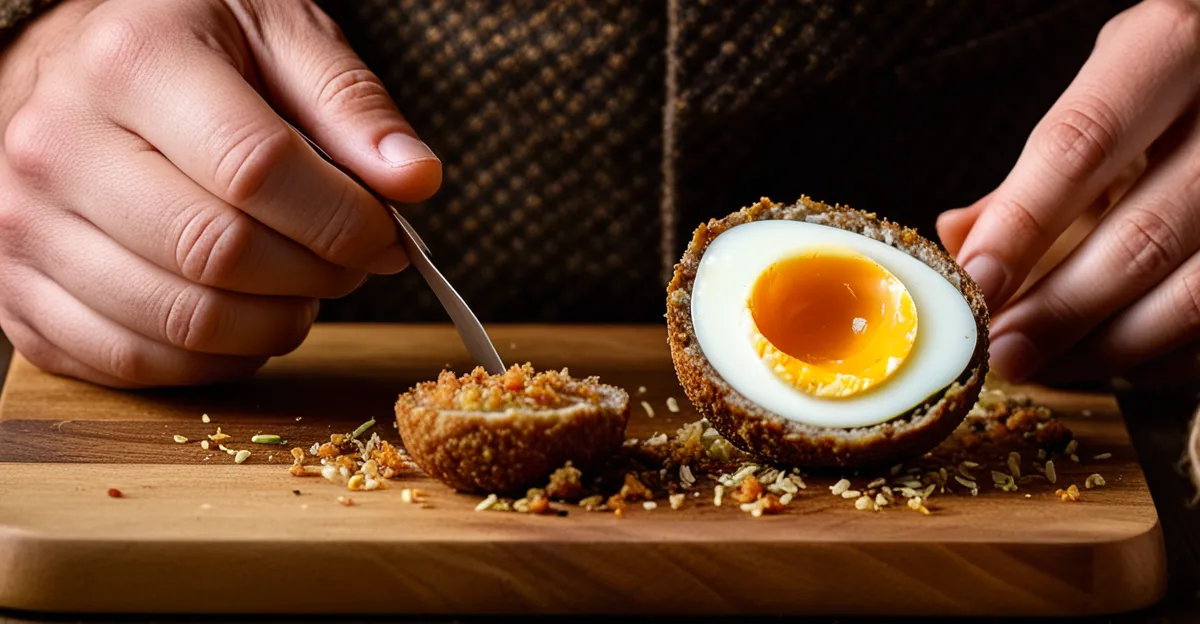Essential Ingredients and Choosing Quality Components
Selecting the right Scotch egg ingredients is crucial for both flavour and texture. When it comes to choosing the best sausage for Scotch eggs, opt for high-quality pork sausage meat with a balanced fat content. Fat ensures juiciness, while a good seasoning mix—typically including sage, thyme, and black pepper—adds the depth needed to complement the egg. Consider finely ground sausage meat to allow it to wrap smoothly around the eggs.
Egg selection impacts the final dish significantly. For those seeking a runny yolk, medium-sized eggs or slightly undercooked eggs suit best. Hard-boiled eggs provide a firmer yolk and classic texture. Using fresh eggs contributes to a smoother peel and better overall results in forming Scotch eggs.
In parallel : How can you make a deliciously creamy Eton mess?
Ingredient tips extend to the coating as well. Choose fine, fresh breadcrumbs for a crisp, light texture. Panko breadcrumbs or homemade dried crumbs give an excellent crunch compared to processed ones, enhancing the Scotch egg’s exterior. Using a mix of flour, beaten egg, and breadcrumbs ensures the coating adheres well and delivers that sought-after crispy finish.
In summary, carefully selecting your sausage, eggs, and breadcrumb coatings makes all the difference in achieving the ideal balance of richness, texture, and crunch in your Scotch eggs.
Also to see : How can you make a comforting shepherd’s pie with a unique flavor?
Step-by-Step Preparation and Assembly
Mastering Scotch egg preparation begins with boiling eggs to the right doneness. To achieve a soft yolk, boil eggs for about 6 minutes, then immediately transfer them to ice water to halt cooking. Medium yolks require 8–9 minutes, and hard yolks about 11 minutes. This precise timing ensures the desired yolk consistency without overcooking.
When wrapping Scotch eggs, start by patting the boiled eggs dry to help the sausage adhere. Divide the best sausage for Scotch eggs into portions slightly larger than each egg to allow full coverage. Flatten the sausage meat into evenly thick discs, place an egg in the center, and gently mould the meat around it. The goal is a smooth, uniform layer with no gaps—this avoids splitting during cooking and ensures even cooking of the sausage.
Forming Scotch eggs calls for attention to compactness. Press the sausage firmly to seal all edges and create a robust outer casing. Uneven layers can cause the sausage to separate or cook poorly. Handling the wrapped eggs gently but firmly will give each Scotch egg a consistent shape. With these careful steps in Scotch egg preparation and forming, you set the foundation for excellent texture and flavour in every bite.
Coating and Cooking for a Perfect Finish
A key step in achieving crispy Scotch eggs lies in mastering the coating techniques. After wrapping the eggs in the best sausage for Scotch eggs, ensure a dry surface by patting each egg lightly with flour before dipping it into beaten egg wash. This creates a tacky base for the breadcrumbs, which should be fine and fresh to achieve the ideal crunch. Using a three-step coating process—flour, beaten egg, then breadcrumbs—helps secure a uniform and adhesive coating, preventing the crust from falling off during cooking.
Choosing between frying Scotch eggs or baking Scotch eggs depends on your texture goals and kitchen setup. Frying at around 170°C (340°F) creates an instant golden crust, sealing moisture inside and producing a classic crispness. Use a neutral oil with a high smoke point like vegetable or sunflower oil to avoid imparting unwanted flavours. Fry the eggs in small batches to maintain steady oil temperature and even cooking.
Alternatively, baking offers a less oily, hands-off option. Preheat the oven to 200°C (392°F) and place coated Scotch eggs on a wire rack to promote air circulation under the eggs. Lightly spray the coating with oil before baking to encourage crisping. Although baking takes longer—about 25–30 minutes—it results in a golden finish with slightly less crunch compared to frying, but still a satisfyingly crisp exterior.
To prevent overcooking during frying or baking, monitor cooking time closely. Overcooked Scotch eggs lose moisture, resulting in dry sausage and crumbly coating. Remove eggs from oil or oven when the crust achieves a consistent golden-brown colour and sausage is fully cooked internally. Allowing them to rest briefly on paper towels after frying drains excess oil, preserving crispness without greasiness.
Mastering these coating techniques and cooking methods ensures Scotch eggs boast the signature golden, crispy shell and moist, flavoursome sausage layer inside, delighting every bite.
Expert Tips, Troubleshooting, and Avoiding Common Mistakes
A frequent Scotch egg mistake is sausage splitting during cooking, which ruins both texture and presentation. This often occurs when the sausage layer is uneven or too thin. To prevent this, ensure the sausage meat fully encases the egg in a smooth, uniform layer without gaps. Firmly pressing the edges together seals the casing, reducing the risk of separation when frying or baking. Also, slightly chilling the wrapped eggs before cooking helps the sausage set and maintain shape.
Maintaining a runny yolk presents a common challenge in Scotch egg troubleshooting. The key is precise timing during boiling—usually around 6 minutes for softly boiled eggs—followed by rapid cooling in ice water to stop further cooking. Avoid boiling too long before wrapping, as residual heat inside the meat can cause overcooked yolks. When frying or baking, moderate temperature control prevents yolk hardening without compromising sausage doneness.
Soggy coatings often result from excess moisture or insufficient adhesion in coating techniques. Pat the wrapped eggs dry before flouring to remove surface dampness. Use the classic three-stage coating—flour, beaten egg, and fine breadcrumbs—to create a robust crust. Avoid overcrowding the pan during frying or placing eggs too close on a baking rack, which traps steam and softens the coating. After cooking, draining fried eggs briefly on paper towels preserves crispness.
For undercooked sausage, verify consistent sausage thickness around the egg—too thick can delay cooking, while too thin leads to dryness. Cooking at even temperatures and using a thermometer can help ensure the centre reaches safe, juicy doneness without overcooking the outside. These expert tips address common pitfalls, helping you perfect your Scotch eggs with reliable, repeatable results.
Serving, Presentation, and Enjoyment
Serving Scotch eggs with style enhances both the eating experience and visual appeal. For perfect Scotch egg presentation, slice the eggs cleanly using a sharp knife, preferably warmed slightly to prevent tearing the crispy coating or smashing the yolk. Cutting in half to reveal the sausage layer encasing the egg yolk offers a striking cross-section that highlights the textures inside. Arranging the halved eggs on a platter with thoughtful spacing draws attention to their shape and golden exterior.
When it comes to serving Scotch eggs, pairing them with complementary accompaniments elevates the flavours. Traditional options like tangy mustard, Worcestershire sauce, or a crisp pickle add sharp contrasts that balance the richness of the sausage. Fresh green salads or lightly dressed slaws bring freshness and crunch which complement the hearty egg and meat. For a casual feast, serving Scotch eggs alongside artisan bread or chutney offers satisfying variety.
Optimal Scotch egg accompaniments also include drinks that cut through richness and refresh the palate. A dry cider or crisp lager works well with the fried or baked eggs. Light herbal teas or sparkling water with lemon can keep the meal balanced without overwhelming flavours.
For leftovers, store cooked Scotch eggs in an airtight container in the refrigerator to maintain texture and freshness. Reheating gently in an oven set to around 160°C (320°F) on a wire rack helps restore crispiness without drying out the sausage or overcooking the yolk. Avoid microwaving, which risks soggy coatings and uneven heating.
Thoughtful attention to serving, presentation, and enjoyment ensures your Scotch eggs remain delightful from first bite to last, whether fresh or reheated.






